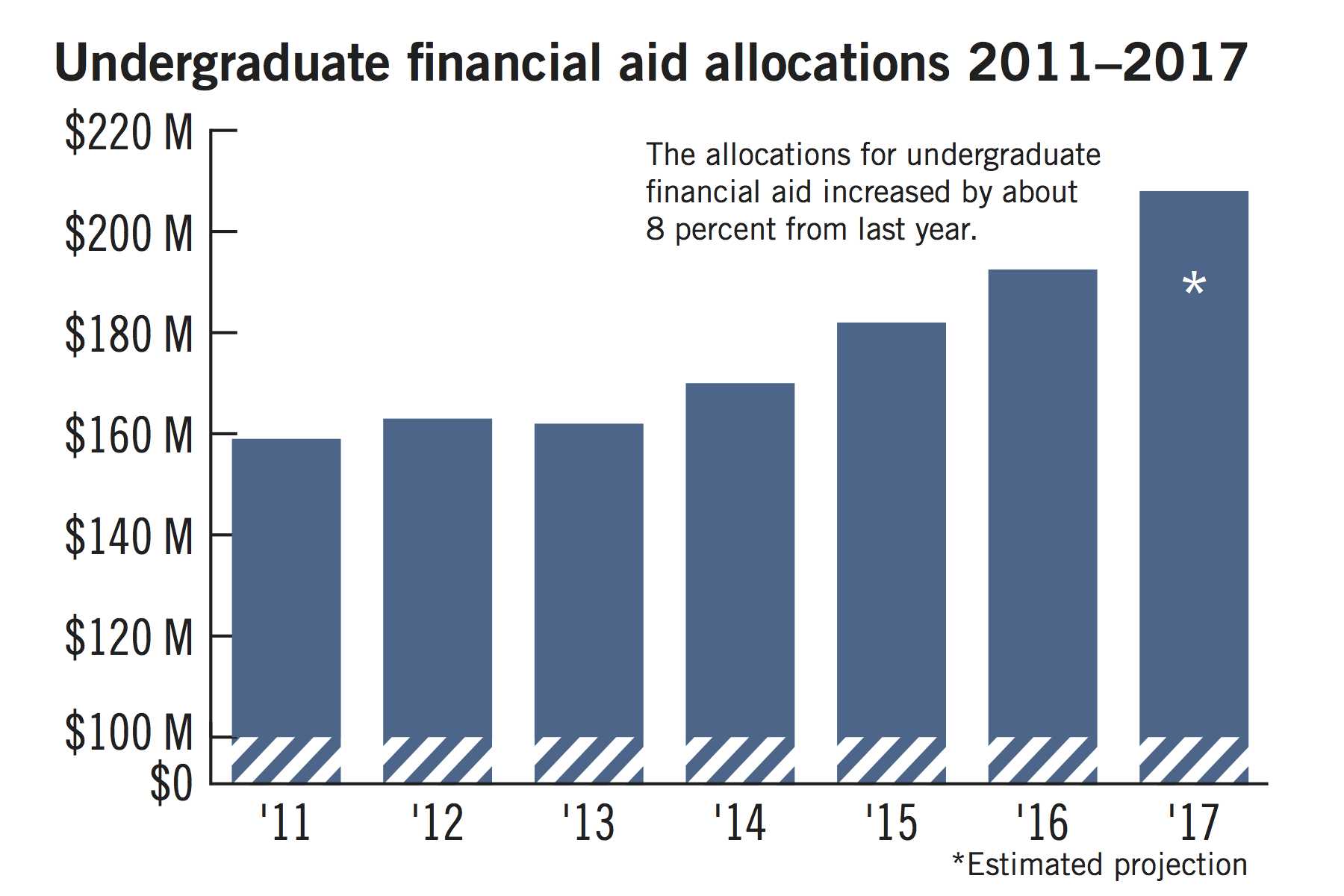
Yonah Bromberg Gaber | Graphics Editor
Source: Board of Trustees
The University will expand its total undergraduate financial aid pool by about 8 percent next fiscal year, the highest one-year increase since at least 2011.
The Board of Trustees approved a $297 million financial aid budget for undergraduate and graduate students at its meeting Friday, a $22 million increase from last year, marking the latest in a series of increases to the University’s financial aid budget since 2013. Officials attributed the budget hike to an increase in tuition and the number of students expected to require aid.
Laurie Koehler, the vice provost for enrollment management and retention, said the pool will award about $207.9 million to undergraduate students, roughly 70 percent of the total aid.
The 8 percent increase in undergraduate aid is the largest since at least 2011, jumping ahead of last year’s 6.9 percent change which brought total undergraduate aid to $192.5 million.
The University has increased its financial aid pool 11 of the last 13 years, only dipping twice in 2007 and 2013.
Koehler said the financial aid increase was partially because tuition will increase 3 percent next academic year for first-year students. Tuition is frozen for all students once they enroll at GW.
But the 8 percent total financial aid increase outpaces the growth of tuition revenue from this year to next, which will clock in at $53,435 – excluding housing – for undergraduate students entering next fall.
More than 65 percent of undergraduates receive scholarship or grant aid, Koehler said.
“It is too early in the admissions cycle to provide any final financial aid numbers,” she said in an email. “However, our goal is to meet the demonstrated need for as many new students who apply for aid as is possible.”
Koehler said the pool also expanded this year because officials expect more students to require financial aid next academic year.
In recent years, officials have moved to increase the economic diversity of the student body, partnering with nonprofits to bring low-income students to campus and switching to a test-optional admissions policy.
Board of Trustees Chairman Nelson Carbonell said this year’s more than $1 billion operating budget, approved by the Board Friday, was influenced by efforts to make the University more affordable.
“We are still short of meeting 100 percent of students’ needs, and we need to continue to work on that to make sure that a GW education is available to anybody,” he said.
Carbonell added that although tuition costs are often the face of University affordability issues, annual budgets also need to consider “all the ingredients underneath that.”
“It’s where philanthropy is a big part, because the more resources we can raise and money we can raise for scholarships, the more we can kind of create that affordability,” he said.
University President Steven Knapp said that the Power and Promise campaign, an arm of the $1 billion fundraising campaign funding student aid scholarships, raised more than $170 million.
He said the University does not have as much funding from endowments for scholarships as some of GW’s peer institutions, so financial aid funds must come out of tuition payments.
“You have this kind of vicious cycle where, in order to make it more affordable, you have to keep raising the price,” he said in an interview earlier this month. “What you want to do is become – to the extent that you can – less dependent on tuition, and more strongly supported by philanthropy and by endowment.”
In 2014, Knapp created a task force to help attract low-income students and address income inequality at the University. GW ranked 151 of 179 institutions on the New York Times’ 2015 list of economically diverse colleges.
Robert Kelchen, an assistant professor of higher education at Seton Hall University, said that an increased pool means that there is more money available for scholarships, likely from an increase in tuition.
“If you’re either higher income or you’re not getting merit aid, it means you’re paying more money to help subsidize other students,” he said.
He said universities nationwide are increasing financial aid and tuition simultaneously to fit the needs of their university. Some universities need to increase these numbers to keep their doors open, while others seek to increase revenue, he added.
“It seems like given the position GW is in, if they’re increasing the financial aid budget that much, it’s more because of choices that they made rather than just having to give out more money to recruit students,” he said. “They can set their own strategy for financial aid rather than just having to give students money in order to get enough students to come.”
Donald Heller, the provost and vice president of academic affairs at the University of San Francisco, said one factor that could influence a continually growing financial aid pool is the growing number of universities high school students apply to each application cycle.
This year, GW accepted a record-high 11,031 students, anticipating that fewer will enroll. GW’s yield rate – the number of accepted students who decide to enroll – droppednearly four percentage points from 2015 to 2016.
“More colleges applied in general means more acceptances, and more financial aid awards,” Heller said in an email. “Students and families often use a financial aid award to bargain with another institution that is higher on the student’s choice list, asking that institution to match or even exceed the financial aid offered by another institution.”
Justine Coleman, Andrew Goudsward and Dani Grace contributed reporting.




